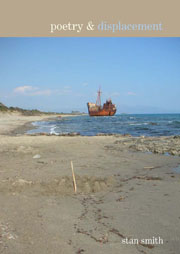Book contents
- Frontmatter
- Contents
- Acknowledgements
- 1 Introduction: Poetry, Place and Displacement
- 2 On the Edge of Things: Philip Larkin
- 3 A Double Man in a Double Place: Iain Crichton Smith
- 4 Salvaged from the Ruins: Ken Smith's Constellations
- 5 Lost Bearings: Christopher Middleton
- 6 ‘What Like Is It?’ Carol Ann Duffy's Différance
- 7 Darkening English: Post-imperial Contestations in Seamus Heaney and Derek Walcott
- 8 Living in History
- 9 An Age of Simulation: Tall Tales and Short Stories
- 10 Nowhere Anyone Would Like To Get To
- 11 Milking the Cow of the World: Displacement Displaced
- Notes
- Bibliography
- Index
1 - Introduction: Poetry, Place and Displacement
- Frontmatter
- Contents
- Acknowledgements
- 1 Introduction: Poetry, Place and Displacement
- 2 On the Edge of Things: Philip Larkin
- 3 A Double Man in a Double Place: Iain Crichton Smith
- 4 Salvaged from the Ruins: Ken Smith's Constellations
- 5 Lost Bearings: Christopher Middleton
- 6 ‘What Like Is It?’ Carol Ann Duffy's Différance
- 7 Darkening English: Post-imperial Contestations in Seamus Heaney and Derek Walcott
- 8 Living in History
- 9 An Age of Simulation: Tall Tales and Short Stories
- 10 Nowhere Anyone Would Like To Get To
- 11 Milking the Cow of the World: Displacement Displaced
- Notes
- Bibliography
- Index
Summary
Displaced persons
In the 1961 Preface to her fictionalised autobiography, The Journal of Mary Hervey Russell, the novelist Margaret Storm Jameson summed up what she saw as the central dilemma of the contemporary self, realised in ‘intuitions which suddenly cut us to the bone’:
Like the moment when I understood that if our age is remembered at all it will be as one when exile was not simply an event, something that happened to a great many men and women, some of whom survived it, but when it became the whole meaning of life. Suddenly I knew that there is nothing else, no closer meaning. Exile. Behind it, what? A void – filled with stones we have touched, streets we looked at in another life, reeds that in another life slashed the finger drawn across them, rotting timbers, images, a young half-effaced smile, the shadow on wet sand of a wave, voices.
For Jameson, it was the experience of the Second World War that brought about this dislocation in being, in the fabric of reality itself, after which nothing could be the same. The exilic modern subject, unable to root itself down in any particular community or place, was now constructed from those ‘moments in and out of time’ of which T. S. Eliot wrote in Four Quartets, a collection published as the war moved into its final phase.
- Type
- Chapter
- Information
- Poetryand Displacement , pp. 1 - 19Publisher: Liverpool University PressPrint publication year: 2007



